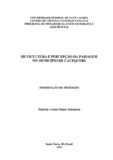| dc.creator | Maass, Patrícia Arend | |
| dc.date.accessioned | 2014-11-11 | |
| dc.date.available | 2014-11-11 | |
| dc.date.issued | 2013-11-19 | |
| dc.identifier.citation | MAASS, Patrícia Arend. SILVICULTURE AND PERCEPTION OF LANDSCAPE IN THE MUNICIPALITY OF CACEQUI/RS. 2013. 74 f. Dissertação (Mestrado em Geociências) - Universidade Federal de Santa Maria, Santa Maria, 2013. | por |
| dc.identifier.uri | http://repositorio.ufsm.br/handle/1/9398 | |
| dc.description.abstract | Since the beginnings of social organization in the land surface, men are concerned with ensuring their vital needs, which translates into different forms of appropriation of geographical space. Faced with this worry, the habit of observing nature to understand the phenomena of the Earth has become a constant in human life. The Geography has the important role of uncovering such phenomena and study the relationships of man's interference with natural processes, whose changes can lead to imbalance of the environment. Accordingly, this paper presents a study of the perception of residents Cacequi/RS with respect to the consequences of changes resulting from the implementation of forestry in the municipality considering the silvicultora activity as a potential factor configuration and reconfiguration of the landscape. It is a search that involves perception, based on the concept of intentionality of the John Searle, analyzing aspects of human cognition that are reflected in the way people relate to their environment. Methodologically, the research was developed from identification, through satellite images, of changes in the landscape resulting from silviculture. The identification of these areas allowed the selection of sites where interviews were conducted with the residents of urban and rural areas of the municipality. Interview data were organized for the interpretation of the results, seeking to highlight the different perceptions expressed by residents regarding the conformation of the landscape. Considering factors such as the features of the landscape, generation jobs and wealth for the city and the environmental impacts resulting from the implementation of forestry, the results obtained from this study reveal positive and negative perceptions among residents, with emphasis on the concern regarding the consequences of silviculture. It is understood, therefore, that the perception of the landscape is reflected incisively about the organization of geographical space. | eng |
| dc.format | application/pdf | por |
| dc.language | por | por |
| dc.publisher | Universidade Federal de Santa Maria | por |
| dc.rights | Acesso Aberto | por |
| dc.subject | Paisagem | por |
| dc.subject | Ecologia da paisagem | por |
| dc.subject | Percepção | por |
| dc.subject | Intencionalidade | por |
| dc.subject | Silvicultura | por |
| dc.subject | Landscape | eng |
| dc.subject | Landscape ecology | eng |
| dc.subject | Perception | eng |
| dc.subject | Intentionality | eng |
| dc.subject | Silviculture | eng |
| dc.title | Silvicultura e percepção da paisagem no município de Cacequi/RS | por |
| dc.title.alternative | Silviculture and perception of landscape in the municipality of Cacequi/RS | eng |
| dc.type | Dissertação | por |
| dc.description.resumo | Desde os primórdios da organização social na superfície terrestre, os homens preocupam-se com a garantia de suas necessidades vitais, o que se traduz em diferentes formas de apropriação do espaço geográfico. Diante de tal preocupação, o hábito de observar a Natureza para compreender os fenômenos da Terra, tornou-se uma constante na vida humana. À Geografia cabe o importante papel de desvendar tais fenômenos e estudar a relação das interferências do Homem nos processos naturais, cujas alterações podem conduzir ao desequilíbrio do meio ambiente. Sendo assim, o presente trabalho apresenta um estudo sobre a percepção dos moradores de Cacequi/RS em relação às consequências das alterações decorrentes da implantação da silvicultura no município, considerando o florestamento como um potencial fator de configuração e reconfiguração da paisagem. Trata-se de um estudo que envolve a percepção fundamentada no conceito de intencionalidade de John Searle, ou seja, analisando aspectos da cognição humana que se refletem na forma como as pessoas se relacionam com o meio em que vivem. Metodologicamente, a pesquisa foi desenvolvida a partir da identificação, por meio de imagens de satélites, das áreas que sofreram maiores alterações decorrentes da silvicultura. A identificação dessas áreas permitiu a seleção dos locais onde foram realizadas entrevistas com os moradores das zonas urbana e rural do município. Os dados das entrevistas foram organizados para a interpretação dos resultados, buscando evidenciar as diferentes percepções manifestadas pelos moradores em relação à conformação da paisagem. Considerando-se fatores como a fisionomia da paisagem, a geração de empregos e riquezas para o município e os impactos ambientais decorrentes da implantação da silvicultura, os resultados obtidos a partir dessa investigação revelaram percepções positivas e negativas entre os moradores, com ênfase para a preocupação em relação às consequências futuras da silvicultura. Entende-se, dessa forma, que a percepção da paisagem reflete-se incisivamente sobre a organização do espaço geográfico. | por |
| dc.contributor.advisor1 | Souza, Bernardo Sayão Penna e | |
| dc.contributor.advisor1Lattes | http://lattes.cnpq.br/4162826845630069 | por |
| dc.contributor.referee1 | Wizniewsky, Carmen Rejane Flores | |
| dc.contributor.referee1Lattes | http://lattes.cnpq.br/9604409518707631 | por |
| dc.contributor.referee2 | Verdum, Roberto | |
| dc.contributor.referee2Lattes | http://lattes.cnpq.br/3794501405530329 | por |
| dc.creator.Lattes | http://lattes.cnpq.br/3571917486491380 | por |
| dc.publisher.country | BR | por |
| dc.publisher.department | Geografia | por |
| dc.publisher.initials | UFSM | por |
| dc.publisher.program | Programa de Pós-Graduação em Geografia | por |
| dc.subject.cnpq | CNPQ::CIENCIAS HUMANAS::GEOGRAFIA | por |


